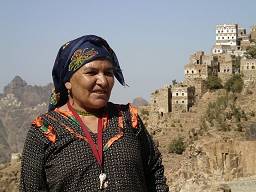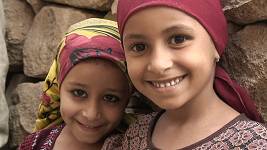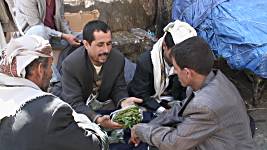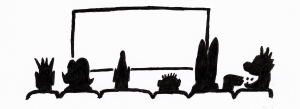
|
The world of non-commercial film and A-V |
Events Diary | Search | ||
| The Film and Video Institute | | ||||
The making of In the Grip of Khat
by Jean-Pierre Hué won The Best Documentary prize and a Diamond
Award at BIAFF 2010.
The film shows life in the Yemen, with special emphasis on how Khat, a controlled drug in many countries, is used as widely and innocently as coffee in Europe with no apparent harm to the population. |
 When you travel in such a country,
you cannot avoid taking beautiful pictures. You plunge into a magical world,
like a children's story, with its unique architecture and a people who are
more than welcoming. It is nothing like media clichés. It is true
that there was war in the north, and problems with the kidnapping of some
tourists. But such incidents are magnified by the media. In fact they are
marginal and less frequent than in France. We always felt completely safe,
more so than in the suburbs of major French cities. When you travel in such a country,
you cannot avoid taking beautiful pictures. You plunge into a magical world,
like a children's story, with its unique architecture and a people who are
more than welcoming. It is nothing like media clichés. It is true
that there was war in the north, and problems with the kidnapping of some
tourists. But such incidents are magnified by the media. In fact they are
marginal and less frequent than in France. We always felt completely safe,
more so than in the suburbs of major French cities.
For ages I had wanted to go to Yemen with my wife Annie. But the news stories deterred us, until that day in October 2009 when we met a Frenchman who lived for 15 years in Yemen. He put us in contact with an official travel agency in Sana'a (Yemen's capital). A fortnight later, we landed in Yemen. In the interim I researched the possible topics I might tackle in the time available. I chose the national phenomenon of qât, then phoned our contact asking him to organise the trip to Sana'a and to a family living in the mountains. |
 We set off with
the little Sony HD camera (A1E), 10 miniDV tapes and a 1 Kg bag of rice as
a camera support (more practical and less cumbersome than a tripod). We were
accompanied by Abdul, our 29 year-old guide and Ali, our driver who was
responsible for looking after us, with whom we quickly established a real
connection and deep friendship. They gave us complete confidence, so
we could devote ourselves fully to discovering the place and above all to
meeting the villagers. We set off with
the little Sony HD camera (A1E), 10 miniDV tapes and a 1 Kg bag of rice as
a camera support (more practical and less cumbersome than a tripod). We were
accompanied by Abdul, our 29 year-old guide and Ali, our driver who was
responsible for looking after us, with whom we quickly established a real
connection and deep friendship. They gave us complete confidence, so
we could devote ourselves fully to discovering the place and above all to
meeting the villagers.
It was not possible to film women without their veils, except in the family and among close neighbours. But what we were permitted was enough. We constantly appreciated the hospitality and the food, pure, simple and well cooked. The only downside was ... no alcohol. But when you are thirsty, nothing beats a little cool water. |
  For the
documentary, the hardest part was the interviews, trying to obtain spontaneous
responses by making them forget the presence of the camera. And then it was
necessary to replay every shot in order for Abdul to translate, noting the
time code of each sentence. Numerous soundscapes were recreated in
post-production. For the
documentary, the hardest part was the interviews, trying to obtain spontaneous
responses by making them forget the presence of the camera. And then it was
necessary to replay every shot in order for Abdul to translate, noting the
time code of each sentence. Numerous soundscapes were recreated in
post-production.
In short, it was an adventure that we probably appreciated more than any other. It left only one desire: to return soon. On our return, we received an email from Abdul: "I did not feel like a guide with his customers, but a son with his parents." |
- Jean-Pierre Hué
 Khat / Qât
Khat / Qât
"Traditionally, qât has been used as a socializing drug, and this is still very much the case in Yemen where qât chewing is predominantly, although not exclusively, a male habit."
"Qât is so popular in Yemen that its cultivation consumes much of the
country's agricultural resources. It is estimated that 40%* of the country's
water supply goes towards irrigating it, with production increasing by about
10% to 15% every year. Water consumption is so high that groundwater levels
in the Sanaa basin are diminishing; because of this, government officials
have proposed relocating large portions of the population of Sanaa to the
coast of the Red Sea."
- notes from
Wikipedia
* The figure accepted in Yemen in 30% as quoted in the film.
Share your passions.

Share your stories.